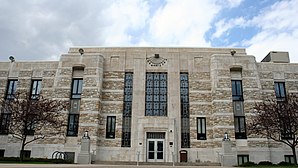Faribault
| Faribault | |
|---|---|
| Nickname : Faribo | |
 Faribault city center |
|
 flag |
|
| Location in Minnesota | |
| Basic data | |
| Foundation : | 1852 |
| State : | United States |
| State : | Minnesota |
| County : | Rice County |
| Coordinates : | 44 ° 17 ′ N , 93 ° 16 ′ W |
| Time zone : | Central ( UTC − 6 / −5 ) |
| Residents : | 23,352 (as of 2010) |
| Population density : | 709.8 inhabitants per km 2 |
| Area : | 33.3 km 2 (approx. 13 mi 2 ) of which 32.9 km 2 (approx. 13 mi 2 ) are land |
| Height : | 303 m |
| Postal code : | 55021 |
| Area code : | +1 507 |
| FIPS : | 27-20546 |
| GNIS ID : | 0643560 |
| Website : | www.faribault.org |
| Mayor : | John Jasinski |
 The Rice County Courthouse in Faribault |
|
Faribault is a town (with the status " City ") and the administrative center of the Rice County of middle-southeast US -amerikanischen state of Minnesota . In 2010 Faribault had 23,352 inhabitants.
Faribault is part of the CSA (Combined Statistical Area) Minneapolis-St. Paul-St. Cloud , the expanded Minneapolis-Saint Paul metropolitan area .
geography
Faribault is located in the southern part of the US state Minnesota in the American Midwest , around 74 kilometers south of the twin cities of Minneapolis and St. Paul .
In Faribault, the Straight River flows into the Cannon River , a right tributary of the Mississippi .
Interstate 35 runs along the city in a north-south direction . According to the United States Census Bureau, the area of the city is 33.3 square kilometers, of which 0.4 square kilometers is water.
history
Faribault was founded in 1852 by the fur trader Alexander Faribault. Faribault came to national prominence in the school and church sectors in the 1860s when Episcopal Bishop Henry Whipple established a collaborative network of schools and churches.
In addition, the state schools for the blind and deaf ( Minnesota State Academy for the Blind and Minnesota State Academy for the Deaf ) founded in 1863 are located in Faribault. In addition to the Faribault Senior High School , the Shattuck St. Mary’s School, which is known as a private boarding school for the awarding of scholarships for talented ice hockey players, is of national importance.
On the initiative of Dorothy Beebe, Faribault took on a city sponsorship for Würzburg in April 1949 in order to supply the city, which had been destroyed by the war, with aid deliveries. This town partnership with Würzburg still exists today.
Demographic data
| Population development | |||
|---|---|---|---|
| Census | Residents | ± in% | |
| 1870 | 3045 | - | |
| 1880 | 5415 | 77.8% | |
| 1890 | 6520 | 20.4% | |
| 1900 | 7868 | 20.7% | |
| 1910 | 9001 | 14.4% | |
| 1920 | 11,089 | 23.2% | |
| 1930 | 12,767 | 15.1% | |
| 1940 | 14,527 | 13.8% | |
| 1950 | 16,028 | 10.3% | |
| 1960 | 16,926 | 5.6% | |
| 1970 | 16,595 | -2% | |
| 1980 | 16,241 | -2.1% | |
| 1990 | 17,085 | 5.2% | |
| 2000 | 20,818 | 21.8% | |
| 2010 | 23,352 | 12.2% | |
| 1870-2000 2010 | |||
According to the 2010 census , Faribault had 23,352 people in 8,317 households. The population density was 709.8 people per square kilometer. Statistically, 2.5 people lived in each of the 8,317 households.
The racial the population was composed of 82.6 percent white, 7.6 percent African American, 0.9 percent Native American, 2.1 percent Asian, 0.1 percent Polynesian and 4.4 percent from other ethnic groups; 2.3 percent were descended from two or more races. Hispanic or Latino of any race was 13.0 percent of the population regardless of ethnicity.
25.2 percent of the population were under 18 years old, 61.7 percent were between 18 and 64 and 13.1 percent were 65 years or older. 45.9 percent of the population was female.
The average annual income for a household was 47,952 USD . The per capita income was $ 21,201. 17.8 percent of the population lived below the poverty line.
Sons and daughters
- Donald Edward DeGrood (* 1965), Roman Catholic clergyman, Bishop of Sioux Falls
- David Grose (1944-2004), archaeologist
- Thomas Lieb (1899–1962), track and field athlete
- Ian McCoshen (born 1995), ice hockey player
- Jordan Parise (* 1982), ice hockey goalkeeper
- Thomas Anthony Welch (1884–1959), Bishop of Duluth
Individual evidence
- ↑ a b c American Fact Finder. Retrieved March 20, 2013
- ↑ Rolf-Ulrich Kunze : Würzburg 1945-2004. Reconstruction, modern city. In: Ulrich Wagner (Hrsg.): History of the city of Würzburg. 4 volumes, Volume I-III / 2 (I: From the beginnings to the outbreak of the Peasant War. 2001, ISBN 3-8062-1465-4 ; II: From the Peasant War 1525 to the transition to the Kingdom of Bavaria 1814. 2004, ISBN 3 -8062-1477-8 ; III / 1–2: From the transition to Bavaria to the 21st century. 2007, ISBN 978-3-8062-1478-9 ), Theiss, Stuttgart 2001–2007, Volume III (2007), Pp. 318-346 and 1292-1295; here: p. 335.
- ↑ History | Faribault, MN. In: www.ci.faribault.mn.us. Retrieved November 22, 2016 .
- ^ City of Wuerzburg: Würzburg twin cities and their twin cities | Citizens' meetings. In: www.wuerzburg.de. Retrieved November 22, 2016 .
- ^ US Decennial Census. Retrieved March 20, 2013
